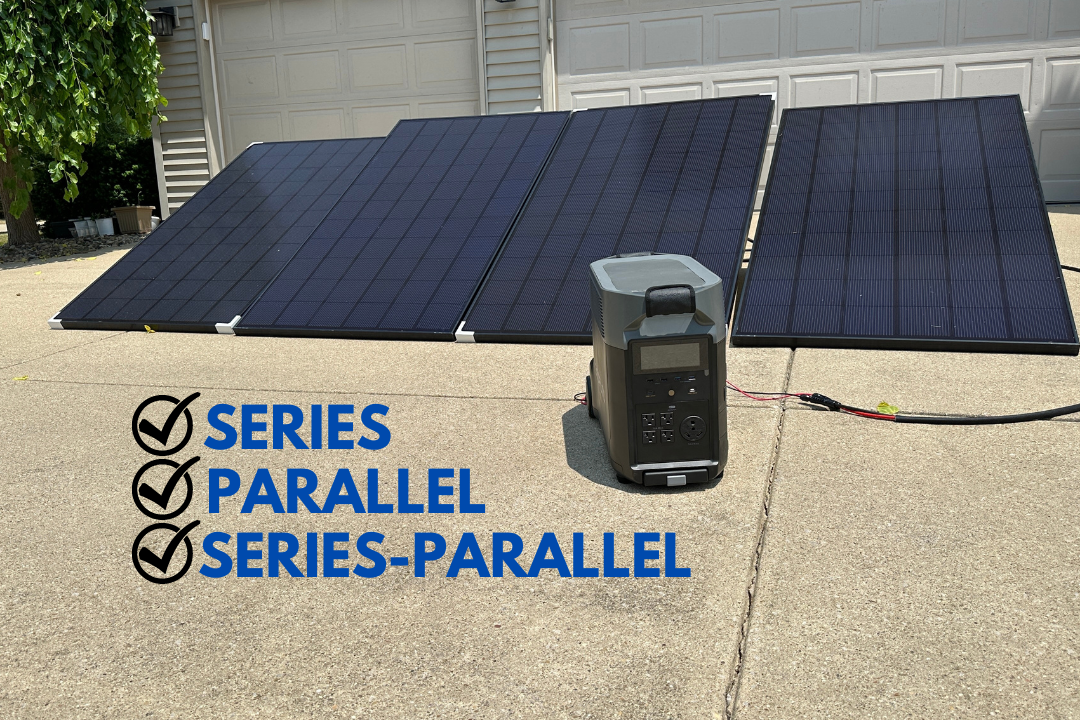
In this article, we’re going to cover the three basic ways to wire up solar panels. The article is based on one of my videos on my YouTube channel, and you can watch the video right here or keep reading. I’ll be demonstrating the different ways for wiring up solar panels with an actual application where we aim to charge up the EcoFlow Delta Pro portable power station using all three methods.
We’ll first take a look at the simplest method, wiring in series. After that, we’ll explore the process of wiring in parallel. Lastly, we’ll tackle the more complex method of wiring using a combination of series and parallel. This information should prove useful when designing your own system, whether it’s for an RV, an off-grid cabin, a garage, a portable power setup, or even your home.
Wiring in Series
Wiring solar panels in series is arguably the easiest of the three methods. In series wiring, the positive of one panel connects to the negative of the next, and so on. This creates a string of panels with a negative wire at the beginning and a positive wire at the end.
However, wiring in series is not always as straightforward as it seems. In order to demonstrate why, let’s take a look at a simplified design using four Heliene 360-watt panels. This shows you why it’s essential to factor in the limitations of your components.
If you multiply the power of each panel (360W) by 4, we’re under the 1600 watts maximum input of our EcoFlow Delta Pro. So, theoretically, we should be able to connect these panels together in series, right? Unfortunately, it’s not that simple.
You might notice that nothing happens when you connect the four panels in series to the Delta Pro. This is because the combined voltage from the four panels exceeds the maximum operating voltage range (150V) of the Delta Pro.
If we reduce the number of panels to three, we fall within the Delta Pro’s operating voltage range, which results in approximately 900 watts of power input. This is because wiring in series results in the system voltage being the addition of the voltage from each panel: 48.6V + 48.6V + 48.6V = 145.8V would be the resulting system open circuit voltage for the three panels.
Wiring in Parallel
The next method of wiring solar panels is in parallel. In this configuration, all the positive ends are connected together, and all the negative ends are connected, maintaining the voltage but adding up the current.
For our demonstration, we’ll only be able to use two panels due to the short circuit current of our panels (9.4A each). Adding these currents together gives us 18.8A, which is above the maximum input current of 15A for the Delta Pro. Unlike the voltage, it is possible to go over the current threshold and still get a charge.
One important thing to note about wiring in parallel is that additional hardware, such as combination connectors, may be needed to bring together the wires from multiple panels.
After wiring our two panels in parallel, we manage to generate around 555-560 watts of power, a noticeable decrease from our series configuration.
Wiring in Series-Parallel
Now, let’s look at a combination of series and parallel wiring, which allows us to effectively bring together four panels. We start by wiring two sets of panels in series. Then, we combine these two sets in parallel.
In this configuration, we’re adding up both our voltages and our currents. We expect to see a total voltage of around 90 volts (45V each from two panels in series), and our currents add up as well.
When you begin to wire in parallel, you’ll quickly notice the necessity for additional wiring. It’s not uncommon to need to create custom wires with MC4 connectors to ensure everything fits together properly. In addition to custom wires, it’s also important to have combination connectors on hand, like these Y branch connectors.
Once wired up, we find that we’re generating around 1145-1150 watts. This is a significant increase from either the series or parallel configurations alone, and much closer to the 1600-watt maximum capacity of the EcoFlow Delta Pro.
Conclusion
Hopefully, this guide has given you a better understanding of series, parallel, and series-parallel wiring configurations. If you plan to use a parallel configuration in a permanent setup, make sure to research and size inline fuses correctly to avoid any issues or damage in the future.
For those considering a home solar setup, we’ve got a team of experienced consultants ready to guide you through the process of selecting and installing a solar power system that not only meets your energy needs today but also caters to your future needs.
Getting the right size system for your house is crucial to offset your energy bill effectively. Just fill out a simple form with a bit of information about your house and what you’re looking for, and we’ll reach out to you within 24 to 48 hours to start the conversation.

